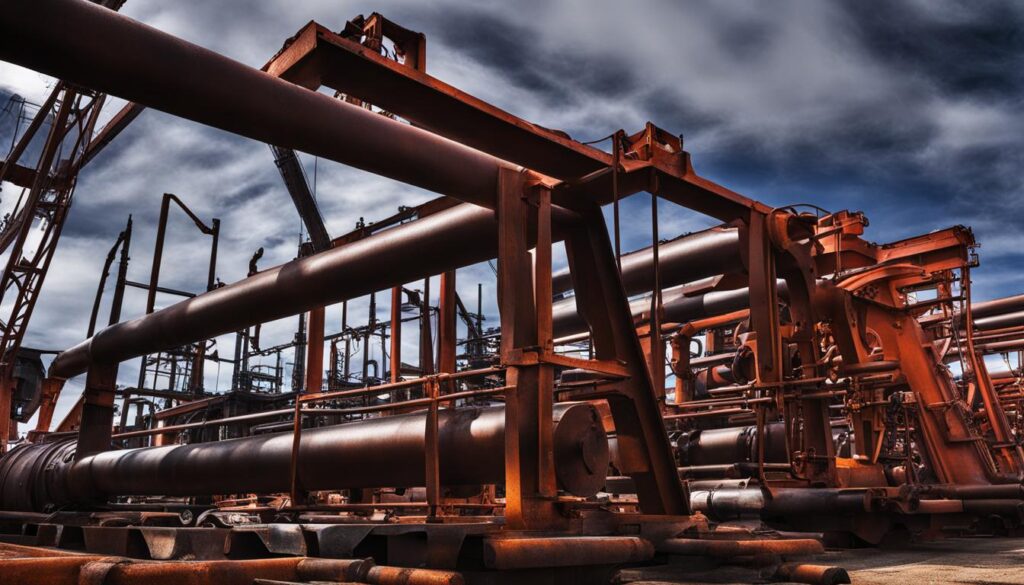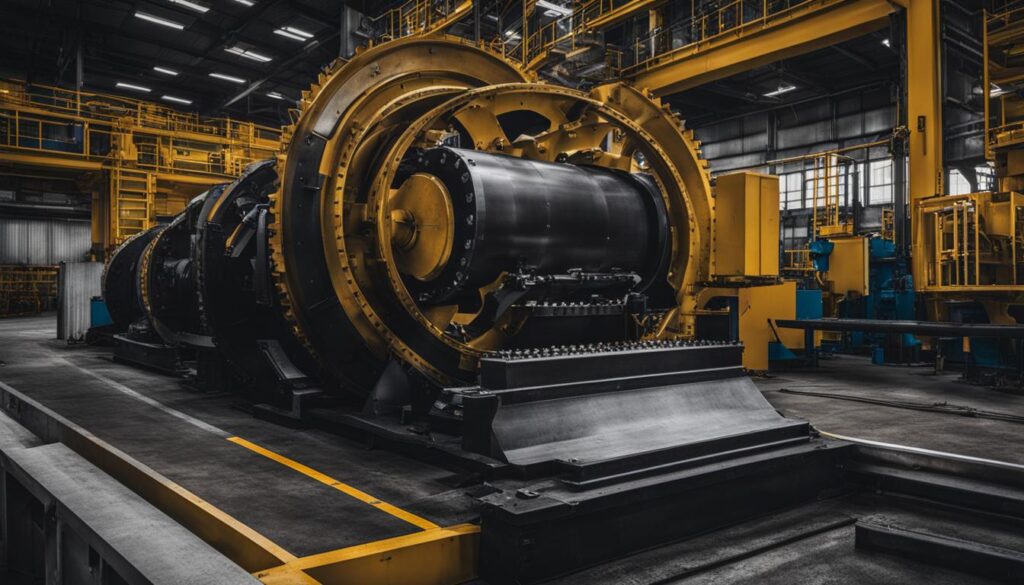Low-alloy steel is a popular choice in many industries due to its enhanced mechanical properties and performance compared to conventional mild or carbon steels. Its unique composition, which generally includes 1 to 5 percent alloy content, provides specific attributes such as improved strength, toughness, hardness, temperature strength, and corrosion resistance. The incorporation of elements like molybdenum, nickel, chromium, manganese, and silicon in varying low-alloy steels allows them to achieve these desirable qualities and offer significant alloy steel casting benefits. As a result, low-alloy steels are utilized across a wide range of industries, including military, construction, oil drilling, and pipeline transport, showcasing the vast applications of low-alloy steel.
Key Takeaways
- Low-alloy steel boasts enhanced mechanical properties compared to conventional mild or carbon steels.
- Specific alloy elements, such as molybdenum, nickel, chromium, manganese, and silicon, improve strength, toughness, hardness, temperature strength, and corrosion resistance.
- Due to its unique characteristics, low-alloy steel finds utility in a wide range of industries, including military, construction, oil drilling, and pipeline transport.
- Low-alloy steel exhibits good weldability, making it suitable for various applications where high strength and durable welds are essential.
- Several grades and types of low-alloy steel address particular industry needs, such as HY 80, HY 90, HY 100, and high-strength, low-alloy (HSLA) steels.
The Fundamental Properties of Low-Alloy Steel
Low-alloy steel is designed to meet stringent mechanical properties facilitated by their specific chemical compositions. The strategic addition of elements like molybdenum, nickel, and chromium can vastly improve the material’s strength, toughness, and resistance to various forms of corrosion and temperature stresses. The introduction of manganese and silicon is instrumental in deoxidizing capabilities, which significantly enhances the steel’s durability and overall performance.

Chemical Composition and Enhanced Mechanical Features
Alloy steel casting composition is a crucial aspect that determines a steel’s enhanced mechanical features. By incorporating specific elements, alloy steel is able to withstand stress and environmental challenges better than its traditional counterpart. Some of the key reinforcement elements added to low-alloy steel include:
- Molybdenum: Increases strength, hardenability, and resistance to wear and corrosion.
- Nickel: Boosts toughness and hardenability while enhancing resistance to corrosion.
- Chromium: Provides higher hardenability, wear resistance, and corrosion resistance properties.
- Manganese: Assists in hardenability and deoxidization while promoting strength and toughness.
- Silicon: Improves deoxidization, strength, and resistance to high-temperature oxidation.
Welding Low-Alloy Steel: Techniques and Filler Metal Selection
While the addition of alloying elements could complicate the welding process, low-alloy steels maintain good weldability. Vital for maintaining weld integrity are understanding the specific low-alloy steel in use and choosing the correct filler metal. Filler metals usually match the chemical and mechanical composition of the base metal and are often classified by their tensile strength. The selection process should account for factors such as the base metal’s strength, desired joint design, material thickness, and specific application requirements such as post-weld heat treating or resistance to cyclic loading and fatigue.
Diverse Industrial Applications of Low-Alloy Steel
Low-alloy steel serves a multitude of applications owing to its advantageous properties. It is essential in constructing military vehicles, ships, bridges, and off-highway vehicles. The different grades of low-alloy steel, such as HY 80, HY 90, and HY 100, as well as the high-strength, low-alloy (HSLA) steels, are specially developed to fulfill the mechanical requirements for these applications. Additionally, ASTM A514, A517, and weathering steels like ASTM A242 serve specific purposes such as heavy machinery manufacturing, pressure vessel fabrication, and creating a weathered appearance in art installations or on building exteriors.
| Low-Alloy Steel Type | Dominant Application |
|---|---|
| HY 80, HY 90, HY 100 | Military Vehicles, Ships, and Bridges |
| High-Strength, Low-Alloy (HSLA) Steels | Off-Highway Vehicles and Structural Components |
| ASTM A514, A517 | Heavy Machinery Manufacturing and Pressure Vessel Fabrication |
| ASTM A242 | Weathered Appearance in Art Installations and Building Exteriors |
Maximizing Low-Alloy Steel’s Potential in Various Industries
Due to their superior mechanical properties, such as high strength, and their cost-effectiveness, low-alloy steels are increasingly becoming the material of choice across various industries. They offer significant alloy steel advantages for applications where high strength is essential, such as mining equipment, while also maintaining good weldability for industries like defense. In the power generation sector, MetalTek’s mastery in alloy steel casting has led to the production of engine cases for turbines using low-alloy steel for its robustness and affordability.
To better understand the industrial uses of low-alloy steel, let’s examine its application in three key sectors – construction, automotive, and aerospace:
- Construction
- Automotive
- Aerospace
Low-alloy steel has transformed the way industries approach material choices, delivering higher strength and performance while also being economical.
Let’s explore these industries individually and analyze the benefits of using low-alloy steel:
| Industry | Application | Benefits of Low-Alloy Steel |
|---|---|---|
| Construction | Building infrastructure, bridges, earthquake-resistant structures | High strength, corrosion resistance, good weldability, and cost-effectiveness |
| Automotive | Vehicle chassis, engine components, suspension systems | Enhanced durability, lightweight, increased safety, and fuel efficiency |
| Aerospace | Aircraft structures, engine components, landing gears | Superior strength-to-weight ratios, temperature resistance, and fatigue resistance |
From the table above, it’s evident that maximizing low-alloy steel potential in various industries leads to improved products, safer designs, and reduced costs. As technology advances, so will the potential of low-alloy steel, continuing to revolutionize applications across various sectors. This versatile material stands to be even more popular and beneficial for industries in the future.
Conclusion
At KT-Foundry, we are dedicated to delivering alloy steel castings that exemplify quality and durability. By leveraging our expertise in low-alloy steel and its numerous applications, we ensure that our alloy castings meet the strictest industry standards and pass our rigorous quality assurance processes. Our commitment to excellence means that we constantly strive to provide castings that not only offer the mechanical and chemical benefits inherent to low-alloy steel but also adhere to our clients’ specific design requirements and operational needs.
Low-alloy steel’s superior mechanical properties and cost-effectiveness make it the material of choice across various industries. From military vehicles and ships to construction projects and power generators, using low-alloy steel translates to increased performance, robustness, and affordability. This widespread adoption of low-alloy steel underscores the need for quality alloy steel castings that cater to the unique demands of each industry.
As a trusted supplier in the alloy steel casting market, KT-Foundry stays ahead of the curve by constantly developing and refining our casting processes. We remain committed to investing in the latest technologies and techniques that can further amplify the positive qualities of low-alloy steel, ensuring that we continue to provide top-tier alloy steel castings for a wide array of applications.
FAQ
What are the key advantages of low-alloy steel?
Low-alloy steel offers improved mechanical properties and performance compared to conventional mild or carbon steels. It exhibits enhanced strength, toughness, hardness, temperature strength, and corrosion resistance, making it versatile and suitable for various industries.
How does the chemical composition of low-alloy steel contribute to its enhanced mechanical features?
Low-alloy steel typically contains 1 to 5 percent alloy content, with elements such as molybdenum, nickel, chromium, manganese, and silicon added to achieve specific attributes. These elements improve strength, toughness, and resistance to corrosion and temperature stresses while enhancing the steel’s durability and overall performance.
Can low-alloy steel be welded easily?
Despite the complexities posed by the addition of alloying elements, low-alloy steels generally maintain good weldability. Essential to this process are understanding the specific low-alloy steel in use and choosing the correct filler metal, which ensures optimal weld integrity.
What are some common applications of low-alloy steel?
Low-alloy steel is used across various industries, including military, construction, oil drilling, and pipeline transport. Its applications include the construction of military vehicles, ships, bridges, off-highway vehicles, mining equipment, and power generation components such as engine cases for turbines.
What are some examples of low-alloy steel grades used in specific industries?
HY 80, HY 90, and HY 100 are examples of low-alloy steel grades used in the construction of military vehicles, ships, and bridges. Additionally, ASTM A514, A517, and weathering steels like ASTM A242 serve purposes such as heavy machinery manufacturing, pressure vessel fabrication, and creating a weathered appearance in art installations or building exteriors.


